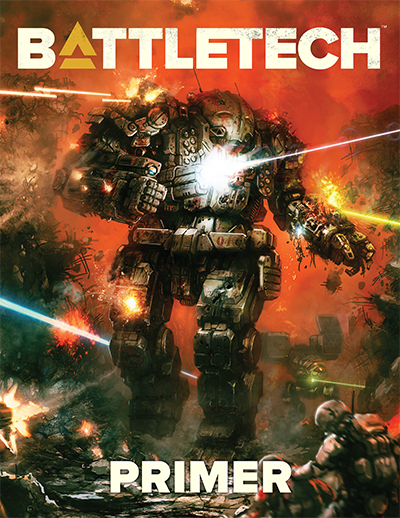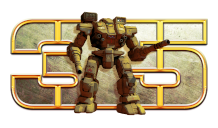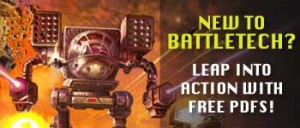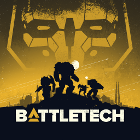- Home
- New To BattleTech?
- MUL
- Forums
- News
- Books
- Shrapnel
- Universe
- Downloads
- Characters
- Community
- Errata
- Links
- Gallery

BattleMech Technology
The modern BattleMech is the end result of more than three thousand years of battlefield technology development. Combining awesome destructive power and unparalleled maneuverability, the BattleMech is perhaps the most complex machine ever produced. The undisputed master of thirty-first century warfare, the BattleMech seems destined to reign supreme centuries into the future.
Every ‘Mech contains thousands of different components, grouped into six primary systems: cockpit, chassis, locomotion/movement,power systems, armor, weapons and electronics, each of which are covered below. The majority of BattleMechs arebipedal designs. However, a few four-legged (or quad) BattleMech designs exist.
Cockpit
Every BattleMech contains a cockpit, usually located in the “head” of the ‘Mech; or a close proximity for those with out a clear ‘head.’ Additionally, though the size of a cockpit might vary-generally the larger the ‘Mech, the larger the cockpit-they all have common features.
The command couch is where the MechWarrior sits, restrained by a six-point harness. The warrior’s coolant vest and medical monitors are tied into the chair and most have a small cubbyhole in the back for stashing clothing and emergency rations. Additionally, a command couch is what a MechWarrior will ride out of the cockpit if he is forced to eject; explosive bolts blow away the top or side of the cockpit and the chair rides to safety on jets.
Joysticks mounted on the arms of the command couch allow a MechWarrior to manipulate a ‘Mech’s arms, as well as to torso twist a ‘Mech and target and fire the ‘Mech’s weapons compliment. Foot pedals control the movement of the ‘Mechs legs. Finally, stomping down on both pedals ignite a ‘Mech’s jump jet system, if it thus equipped.
Directly in front of the MechWarrior is a primary view screen, which displays a computer generated, three-sixty degree view of the surrounding area shrunk into a single front view. The targeting reticule appears on the screen, manipulated by the joysticks, to show when a target lock has been achieved. The screen can magnify images.
Above and below and to the right and left of this main screen-the exact placement is different in various designs-are secondary monitors. The radar screen is usually directly below the view screen and can be toggled through a variety of settings: standard, infrared, magnetic anomaly, motion, and so on. The status schematic shows a wire outline of the ‘Mech and tracks external and internal damage, as well as displaying a ‘Mechs offensive and defensive capabilities. A map display allows the MechWarrior to toggle through virtually endless sets of maps, all pre-loaded into the computer, and in some cases can even be tied into local satellite and command headquarter communication systems to get real-time images.
Neurohelmet
All of those systems would mean nothing with out the neural impulse helmet, which actually allows a twelve-meter tall metal giant to walk upright. Commonly called neurohelmets, these bulky items normally cover a MechWarrior’s entire head, attaching firmly to the shoulders of his cooling vest. Electrodes on the interior of the neurohelmets channel sensory information from the BattleMech directly to the pilot, converting raw data on posture, movement, balance and speed into neural impulses for the human brain. At the same time, the helmet and its linked computer translate impulses from the MechWarrior’s brain into signals transmitted directly to the ‘Mech’s gyroscope and myomer musculature. In this way, the pilot controls the reflexive bodily movements of the BattleMech subconsciously, leaving his conscious brain free to control the various weapons and other systems as needed.
Chassis
Every BattleMech contains a chassis that consists of several dozen “bones.” Each “bone” is a honeycombed, foamed-aluminum core wrapped with stressed silicon-carbide monofilament and protected by a rigid, titanium-steel shell. Each of these artificial “bones” has attachment points for their myomer “muscles” and servos that drive the BattleMech. This skeletal construction helps make BattleMechs less vulnerable and easier to repair than vehicles supported by stressed-skin shells.
A special type of internal structure called ‘endo steel’ has been developed, which is bulkier then the standard skeleton of a ‘Mech, but it weighs half the standard tonnage.
Power Systems
BattleMechs require a large, constant power supply for movement and combat. The fusion reactor, which produces enormous amounts of electricity from ordinary water, is the most efficient system for providing this power. Because the fusion reaction created by a BattleMech’s power plant does not release neutrons, the power plant can operate indefinitely without becoming radioactive.
The fusion plant produces electricity by a process known as magneto hydrodynamics. In this process, magnetic fields are used to channel plasma from the fusion reaction into a loop. This plasma is electrically conductive, and so the loop functions as a powerful generating coil, producing both electricity and waste heat. Every BattleMech carries radiators called heat sinks to help dissipate this waste heat. Heat sinks are especially important because excessively high internal temperatures can disrupt the magnetic containment fields around a BattleMech’s reactor. If a power plant’s magnetic “jar” is disrupted, an uncontrolled fusion reaction may occur, releasing neutrons and exposing the BattleMech’s internal systems and its MechWarrior to lethal radiation.
There are three types of ‘Mech engines in common use-standard, light and extra-light (XL); the light and extra-light fusion engines each weighs successively less, but increases in over all size and bulk.
Locomotion/Movement Systems
Two different systems are used to drive BattleMechs and control their movements. Small, electrically driven actuators move a ‘Mech’s light weapons and sensor arrays. Bundles of polyacetylene fibers called myomers control a ‘Mech’s limbs and main weapons. Myomers contract when exposed to electrical current, much like human muscles. If a BattleMech’s myomers are damaged in battle, technicians can replace the fiber bundles with new ones or “transplant” myomers from other parts of the ‘Mech’s skeleton. Transplanted myomer bundles cannot restore full function to a damaged limb, but they do provide limited mobility and strength.
Movement Capabilities
BattleMechs can attain walking or running speeds ranging from forty to well over one hundred kilometers per hour in open terrain. Dense forests, swamps and steep slopes will slow a ‘Mech, but very few terrain features can stop one. In addition, many ‘Mechs can jump over obstacles by superheating air with their fusion reactors and releasing it through so-called jump jets. (Jump-capable BattleMechs operating on worlds without atmospheres often carry small quantities of mercury to use as reaction mass for their jets.) All BattleMechs can also move under-water when crossing rivers or small lakes.
Space borne BattleMechs can make assault landings from low orbit. Special reaction jets housed in their feet allow them to soft-land from altitudes of up to 320 kilometers. During re-entry, breakaway ablative shields protect a BattleMech’s vulnerable sensors and weapons.
Heat-Dissipation Systems and Strategies
Because of a BattleMech’s systems are pushed to their limits during combat, ‘Mechs engaged in combat rapidly generate large amounts of waste heat-heat that can disrupt a fusion reactor’s magnetic containment shields and impair or permanently damage a ‘Mech’s electronics and computer systems, thereby slowing the BattleMech’s movement and reducing the accuracy of its weapons.
Heat sinks are one way of controlling the heat build-up in a ‘Mech. The heat pouring out of these radiators can produce strong infrared 9(IR) signatures, however, which can make a ‘Mech easy to target. To sidestep this problem, MechWarriors have found other ways to control heat build-up. MechWarriors often place their machines in shallow lakes or rivers. (Through the processes of conduction and convection, moving water helps dissipate a ‘Mechs internal heat.) On temperate or cold worlds, the atmosphere itself can help dissipate waste heat. On the other hand, the high outside temperatures of a desert or jungle environment can exacerbate a BattleMech’s heating problems.
The most common methods by which MechWarriors control heat build-up are manually regulating the movement and firing rates of their ‘Mechs or reprogramming the machine’s movement-control computer and its secondary systems. These computers can be used to limit the ‘Mech’s rate of activity and the resulting heat build-up. For example, when a ‘Mech is sent to a high-temperature world, its activity-rate setting may be lowered. The ‘Mech will move more slowly and fire less often than it would on a temperate planet. When a ‘Mech is sent to fight in an arctic climate, the setting is raised, allowing faster movement and a higher rate of fire. Reprogramming is usually carried out while a BattleMech force is enroute to its assignment aboard DropShips. The process takes approximately two weeks.
Because BattleMechs are always adjusted for the expected external temperature of their combat environments, sudden increases in outside temperature can have a devastating impact on a ‘Mech’s ability to dissipate waste heat. Tacticians have developed a whole series of battle tactics to take advantage of this ‘Mech characteristic. For example, commanders regularly set forests on fire while enemy BattleMechs are advancing through them. The superheated air roaring around the ‘Mech can overload the machines’ cooling systems or drastically reduce their efficiency, thus hampering the BattleMechs’ combat capabilities.
Armor
Two separate layers of armor provide BattleMechs with protection against energy and projectile weapons. Aligned-crystal steel is usually used for the outer layer of ‘Mech armor. The aligned-crystal steel has excellent heat-conducting properties, and so it provides excellent protection against lasers and particle-beam weapons. An inner layer of boron nitride impregnated with diamond monofilament stops high-explosive armor piercing (HEAP) rounds and fast neutrons. This second layer of armor also prevents any armor fragments from damaging a BattleMech’s internal systems.
In addition to standard armor, there are two different types of specialty armor in general use, each of which is outlined below.
- Ferro-Fibrous Armor
- Ferro-fibrous armor is an improved version of ordinary BattleMech armor that uses woven fibers of ferro-steel and ferro-titanium to greatly increase its tensile strength. However, ferro-fibrous armor is bulkier than standard armor plating of equivalent weight.
- Stealth Armor
- Stealth armor is a very recent technology and is currently exclusive to the Capellan Confederation. Using the shape and composition of the ‘Mech’s armor as the corner stone of the system, as well as tied to a Guardian ECM Suite, the system makes the unit more difficult to target at longer ranges, effectively given the ‘Mech a ‘stealth’ ability.
Weapons
BattleMechs can mount a wide variety of weaponry. Because energy weapons can be powered virtually indefinitely by a ‘Mech’s onboard fusion reactor and do not require ammunition reloads, BattleMechs usually carry charged-particle-beam weapons or lasers as their primary armaments. Additionally, many BattleMechs carry launching racks for short- or long-range, non-nuclear missiles. Still other ‘Mechs mount rapid-fire autocannons or machine-guns for use against infantry, aircraft and other BattleMechs. Below is a basic overview of each weapon type.
- Autocannons
- An autocannon is a rapid-firing, auto-loading weapon that fires high-speed streams of high explosive, armor-piercing shells. ‘Standard’ autocannons may utilize numerous submunitions-such as armor piercing, flechette, incendiary and precision. Additionally, there are three types of autocannon that incorporate advanced effects: LB-X, Rotary and Ultra autocannonsAutocannon ammunition can explode inside a ‘Mech, either due to critical damage or the effects of a ‘Mech overheating and cooking the ammo off.
- Flamers
- The typical flamethrower carried by ‘Mechs taps into the heat generated by the fusion reactor to create a powerful but short-ranged burst of fire. These weapons are rarely mounted on ‘Mechs due to their poor heat-to-damage ratio, but they can be useful incendiary weapons.
- Gauss Rifles
- The Gauss rifle uses a series of magnets to propel a projectile through the rifle barrel toward a target. While it requires a great deal of power to operate, this weapon generates very little heat and can achieve a muzzle velocity twice that of any conventional weapon. There are Heavy, standard and Light gauss rifles. Unlike autocannons, Gauss rifle ammunition does not explode, but if the weapon itself is damaged, it will explode.
- Hatchet
- Some Inner Sphere BattleMechs come equipped with a hatchet, which mounts a depleted uranium edge for cutting into armor. The hatchet stays attached to the ‘Mech and must be swung at the target to inflict damage. A variant on the Hatchet weapon is a sword.
- Lasers
- A laser damages its target by concentrating extreme heat on a small area. BattleMech lasers are designated micro, small, medium and large, which corresponds to their range and damage. There are also Extended Range, Heavy and Pulse class lasers. Lasers do not explode when damaged and require no ammunition but they cause a significant amount of heat.
- Machine Guns
- Though rarely carried by BattleMechs, the high rate of fire produced by machine guns makes them excellent anti-infantry weapons. There are Heavy and Light machine guns.
- Missile Launchers
- Missile launchers are devices used to deliver self-propelled and self-guided munitions to inflict damage on a target. There is a plethora of missile launchers: from long-range, to medium-range, to short-range to advanced missile types such as the Clan’s Advanced Tactical Missile System or Streak short-range missiles. Additionally, ‘standard’ long-range missile launchers can accommodate numerous submunitions-such as Flare, Fragmentation, Incendiary and Semi-guided, to mine-laying Thunder munitions. Like autocannons, missile launcher ammunition can explode due to damage or excessive heat.
- Particle Projector Cannons (PPC)
- A PPC consists of a magnetic accelerator firing high-energy proton or ion bolts that cause damage through both impact and high temperature. PPCs are among the most effective weapons available to BattleMechs. Standard and Extended-Range PPCs exist.
Other Equipment
In addition to Armor and weaponry ‘Mechs can mount a wide array of other systems. Many are electronic systems that can increase weapon accuracy or provide defensive countermeasures, while a handful are purely mechanical systems performing a variety of defensive roles.
- Active Probe
- Capable of detecting and identifying even shutdown and camouflaged units at a distance much greater than standard issue electronic warfare (EW) suites, the active probe makes a valuable addition to any recon unit.
- Anti-Missile System
- The anti-missile system (AMS) is a rapid-fire, point-defense machine gun capable of tracking, engaging, and destroying incoming missiles. While very effective, the system’s primary drawback is its high ammunition consumption.
- Anti-Personnel Pods
- Anti-Personnel pods (A-pods) consist of directional mines installed on the lower legs of a BattleMech-which is precisely where infantry must attack if they plan to plant explosives on the sensitive actuator mechanisms.
- Artemis IV Fire Control System
- The Artemis IV fire-control system improves the accuracy of standard missile launchers.
- C3 Computer
- The Command/Control/Communications (C3) computer system is an Inner Sphere only system that allows multiple units-to a maximum of twelve-to share targeting data, thus making accurate fire resolution much more precise. The system has sever drawbacks, however, in that parts of the network can be ‘lost’ due to the destruction or damage of the ‘primary master computers’ or due to the interference of an enemy electronic counter measure suite. An Improved C3 Computer exists that eliminates the problems of losing the network due to the lose of the ‘master computers’ but it can only tie in six total units.
- Cellular Ammunition Storage Equipment (CASE)
- CASE is a damage-control technology that mitigates the effects of internal ammunition explosions. When ammo explodes in a location protected by CASE, the force of the explosion blows out through specially designed panels and armor, directing the main force of the explosion away from the BattleMech’s vital component, such as the cockpit or the engine.
- ECM Suite
- The Guardian ECM suite is a broad-spectrum jamming and electronic countermeasure device designed to reduce the effectiveness of enemy long-range scanning and surveillance equipment.
- Myomer Accelerator Signal Circuitry (MASC)
- MASC allows a BattleMech to put on a short burst of speed, at some risk to its fragile leg actuators. It works by boosting the signals to the myomer leg musculature, causing those muscles to contract and relax at a quicker rate than is usually possible. This increases speed, but the stress to actuators and myomer can cause a catastrophic failure especially after prolonged MASC use.
- Narc Missile Beacon
- The Narc missile beacon is a heavily modified missile launcher that fires special missiles, called pods, made up of powerful homing beacons mounted behind a magnetic head. If the missile hits the target, the pod broadcasts a homing signal for any friendly missile systems equipped to receive Narc transmissions. Like the Artemis IV system, Narc pods potentially increase the number of missiles that hit a target. It can also fire an explosive pod. An Improved Narc launcher has been developed that not only increases the range of the standard model but can also fire the following special submunitions: Homing, Explosive, ECM, Haywire and Nemesis.
- Target Acquisition Gear (TAG)
- A spotter uses target acquisition gear to designate a target for attack by a homing missile fired from an Arrow IV Missile Artillery System or semi-guided missiles fired from an LRM launcher. The Clans also employ a light version of the TAG, which weighs less but has less range.
- Targeting Computer
- In addition to the various special targeting systems developed for missiles, the Clans developed an advanced targeting system, only recently matched by the Inner Sphere, that can enhance the performance of the following types of direct-fire weapons: lasers, PPCs, Gauss rifles, and autocannon.
- Triple-Strength Myomer
- Inner Sphere scientist have developed a special type of myomer “muscle” that becomes exceedingly strong when a ‘Mech overheats. This technology is not available to Clan BattleMechs.
 BattleTech is a science-fiction “space opera”: a factional, militarized universe set in the thirty-first century, a future where humanity has spread to the stars and spawned titanic interstellar empires, each nation controlling hundreds of worlds across a region of space stretching a thousand light years and beyond.
BattleTech is a science-fiction “space opera”: a factional, militarized universe set in the thirty-first century, a future where humanity has spread to the stars and spawned titanic interstellar empires, each nation controlling hundreds of worlds across a region of space stretching a thousand light years and beyond.
Initially published over thirty years ago as a tabletop board game, BattleTech has gone on to become one of the gaming industry’s most important and longest-lasting science-fiction universes.
Be sure to check out the latest BattleTech Releases and the Coming Soon page for the newest BattleTech products.






